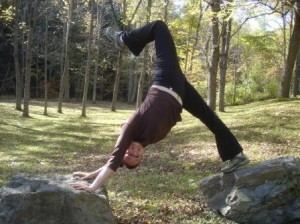We had a feast of lots of food and family and love over the past several days. It’s been wonderful, and now, on Sunday, I’m curled up on the couch relaxing.
For Thanksgiving, I have this recipe that I always brag about, and people ask me for it. Now that I have a blog, I thought this would be the best place to put it up. This recipe came about because in general, I’ve been a vegetarian since I was about 12. So, I really wanted a wonderful main course meal on Thanksgiving after years of just eating the side dishes and not feeling very satisfied. Hence, I present you with the:
HARVEST VEGETABLE TORTE
Based off of a Vegetarian Times 2001 recipe
Layers of mashed sweet potato, mushrooms and leeks, spinach and cheese all wrapped up in a scrumptious puff pastry.
2 large sweet potatoes (1 ½ pounds)
2 TBS butter
2 large eggs
2 TBS olive oil
¾ cup chopped leeks
12oz mushrooms
3 cloves garlic
2 TBS chopped fresh thyme, or ½ tsp. dried
15-oz container lowfat ricotta
2-4 oz feta cheese
2 10-oz. pkgs frozen chopped spinach, thawed and squeezed dry
¼ cup fresh dill
3 egg whites
¼ tsp. red pepper flakes
1 package (17 ¼ oz.) frozen puff pastry, thawed
Egg wash: 1 beaten egg mixed with 1 tsp. water
Fresh herb sprigs for garnish (or extra puff pastry cut into shapes)
- Peel and chop sweet potatoes and boil until tender, about 20 minutes. Drain and then mash with butter, eggs, salt and pepper until smooth. Set aside.
- Saute leeks until soft, and then add mushrooms and garlic. Add thyme, salt and pepper at the end, and set aside.
- Mix ricotta cheese, feta cheese, spinach, dill, egg whites, red pepper flakes until well mixed.
- Preheat oven to 375F. Unfold one pastry sheet and place on lightly floured surface. Roll out to a 14-inch square, then cut into a 14-inch circle. Transfer to ungreased 81/2 or 9-inch springform pan and press gently to fit into bottom and side (there should be some overhang for folding over top of pie).
- Spoon sweet potato mixture into pastry and pat into even layer. Then top with mushroom and leeks, and then spinach mixture. Fold pastry overhang on top.
- Roll out only slightly the second puff pastry sheet on lightly floured surface, then cut into a 9 inch circle. Place over top and press edges together to seal. Brush top with egg wash, and then make a few simple slash on top of pastry with sharp knife.
- I like to add cut out hearts on top with the leftover edges of the first puff pastry.
- Bake 35-40 minutes. When well browned, loosely cover top with foil. Reduce heat to 350F. Carefully remove side of pan and brush sides with egg wash. (If you don’t think the sides feel done, keep baking until they do). Bake until sides are golden, about 35-40 minutes. Remove from oven and let cool slightly before cutting into wedges.
Per serving: 445 cal. 14g protein; 24g fat (6g. saturated); 46g carbs; 5g fiber
Here we are about to dig into the torte:
And here’s what it looks on the yummy inside:
My boyfriend is already trying to convince me that we should make this more than once a year. I am holding fast that this is my Thanksgiving recipe, for once each year. But it really is good…
As for what this has to do with yoga – all I can say is that we’ll be doing a lot of yoga and exercise to counteract the effects of the past few days 🙂


